If you enjoyed reading “Stan in Japan,” you may want to follow my blog on my 2016 move to Texas to help plant a church in the north Dallas area. You can read all about it at A Plano Life.
Stan in Japan
I recently traveled to Japan with senior Pastor Steve Langley and nichigo Pastor Eiji Osato from my church, Gardena Valley Baptist Church. We went to visit Rifu Oasis Chapel in northeastern Japan to see how we might partner with the church, which is engaged in providing relief to the victims of the great earthquake and tsunami of March 2011. The following are my experiences, observations, and musings from that trip.
Monday, October 1, 2012
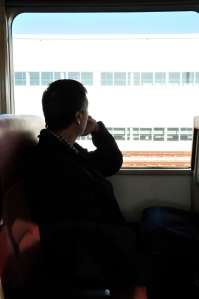 Making the long (over 11-hour) trip from Los Angeles to Tokyo, I’m thinking about my family history, my faith, the gospel, God’s sovereignty, and why I’m going to Japan at this time in my life.
Making the long (over 11-hour) trip from Los Angeles to Tokyo, I’m thinking about my family history, my faith, the gospel, God’s sovereignty, and why I’m going to Japan at this time in my life.
I’m a third generation Japanese-American (sansei). My grandparents left Japan nearly a hundred years ago seeking fortune in America, specifically California which the Chinese gave the hopeful name Gold Mountain. My grandparents didn’t make much fortune there, but what they did find was much struggle and hard work, some heartache, and more than a little racism and persecution. Still they persevered and thrived, like weeds sprouting in the fields. Which reminds me, they did a lot of farming.
What they also found was a new life, new ways of thinking and doing things, a chance to reinvent themselves (they would never think in those terms). This new life was all far removed from the rigid, circumscribed life in Japan.
So flying into Japan, I’m thinking what if my grandparents had never left Japan? Then my mother as an 18-year-old growing up in Los Angeles would never have heard the gospel for the first time from a co-worker as they sat in the back of a produce truck going to work. And she never would have heard the gospel again and come to faith a few years later during WWII as a nursing student in Oklahoma through the witness of some of her southern Baptist fellow students. And I never would have grown up in a Christian home in Downey, California.
It’s like “It’s a Wonderful Life.” In that film the angel Clarence says to the Jimmy Stewart character, “Each man’s life touches so many lives. When he isn’t around, he leaves an awful hole, doesn’t he?”
So none of this would have happened in my life. Or would it? No, I believe that God has his sovereign way of working out his plans, weaving his purposes into our lives. The Ruler of all fills in those awful holes, calling us into the kingdom of his beloved Son.
Flying into Japan, I remember and am filled with gratitude for God’s saving work in my life. And I can’t help but recognize the beautiful irony. My grandparents left this Land of the Rising Sun seeking wealth and a better life for their family. And now I their grandson return as one who found real wealth, the pearl of great price, the unsearchable riches of Christ who is the true risen Son.
Tuesday, October 2, 2012
We touched down at Narita airport at around 2:30 p.m., took a bus to Tokyo, and settled into our hotel.
 Just before we left L.A., my friend Cyril Nishimoto, who is executive director of the evangelistic organization Iwa, shared with me that our friend, author Naomi Hirahara, had recently spent two weeks in Japan in the area we’re going to with a team participating in relief efforts with Grace Mission Tohoku (GMT). GMT is the combined ministry of Help Tohoku (of Oyumino Church in Chiba) and Grace City Relief (of Grace City Church Tokyo). Their goals are to build community, rebuild homes, and provide jobs for people in the area. It seems that GMT has had a positive impact, offering assistance and hope and demonstrating a visible and caring witness for Christ.
Just before we left L.A., my friend Cyril Nishimoto, who is executive director of the evangelistic organization Iwa, shared with me that our friend, author Naomi Hirahara, had recently spent two weeks in Japan in the area we’re going to with a team participating in relief efforts with Grace Mission Tohoku (GMT). GMT is the combined ministry of Help Tohoku (of Oyumino Church in Chiba) and Grace City Relief (of Grace City Church Tokyo). Their goals are to build community, rebuild homes, and provide jobs for people in the area. It seems that GMT has had a positive impact, offering assistance and hope and demonstrating a visible and caring witness for Christ.
Pastor Steve, Pastor Eiji, and I walked around the Shinjuku area of Tokyo for an hour. It’s a bustling part of the city, like Manhattan. Then Pastor E iji took us to a restaurant at the top of a skyscraper where his father had taken him as a boy, and we had dinner with a breathtaking view of Tokyo at night.
iji took us to a restaurant at the top of a skyscraper where his father had taken him as a boy, and we had dinner with a breathtaking view of Tokyo at night.
Wednesday, October 3, 2012
After a fitful night of sleep for each of us, we got up and had a delicious American/Japanese breakfast at the hotel. Then we caught a commuter train that took us to the Shinkansen (bullet train) headed for Sendai.
After a speedy one-hour ride we disembarked at the Sendai station, where we had lunch at one of the ubiquitous Japanese noodle shops. As we were leaving the place, Pastor Eiji couldn’t find his train ticket. He pulled out all his pockets, looked through all his bags, went back into the restaurant, searched everywhere, but no ticket.
I’m somewhat of an expert at losing things, which I blame partly on my age, so I said a little prayer and went back and re-traced our steps through the train station. Still no train ticket, so I went back into the restaurant, and there on the chair at our table was the missing ticket!
I have many stories to tell of my losing things and God finding them, as do members of my small group back home. But all of our little stories, as well as Jesus’ parables in Luke 15, point to the gospel and God’s greater story of how he seeks and saves the lost and rejoices when they are found.
This is all a good reminder to me as we travel on in Japan.
We met Yoshi Kikuchi at the station. Yoshi is a staff member of Rifu Oasis Chapel, and he and two fellow church members visited our church this past summer. We got into Yoshi’s car, and he gave us an initial tour of a nearby area that had been devastated by the earthquake and subsequent tsunami of 3/11.
This afternoon was gray and drizzly, which matched the somberness of what we saw. This area had all been vacated – a ghost town. The houses still standing are boarded up; when you are able to look inside, you see the first-floor rooms filled with dirt and rubble.
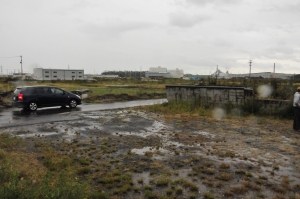 This area was different from what I expected. I had thought it would be more rural with fewer, older houses and structures. But these were neighborhoods – Japanese versions of beach communities back in California, places like Redondo Beach or Huntington Beach – people’s neighborhoods that were wiped out in a few dreadful minutes.
This area was different from what I expected. I had thought it would be more rural with fewer, older houses and structures. But these were neighborhoods – Japanese versions of beach communities back in California, places like Redondo Beach or Huntington Beach – people’s neighborhoods that were wiped out in a few dreadful minutes.
Here there were a few vacant houses standing amid the bald foundations of those houses that had been washed away. But other areas were bereft of any buildings; only bare foundations remained among the weeds. They’ve pretty much cleaned up the site. Dirt and debris have been bulldozed to form huge mountains. Car skeletons and scrap metal have been compacted into great bundles and stacked up, forming other great mountains.
We passed a large modern elementary school, now deserted and enclosed by chain link fencing, where 650 students and residents had fled to during the tsunami. When the waters engulfed the building, they escaped to the roof where they were saved later by helicopter. No one was lost. Yoshi told us that the principal of the school is a Christian, and he said that part of his daily prayers had always been for the safety of the children and townspeople.
 We saw a couple of places where small altars had been placed along the road and then drove to the site of Seaside Baptist Chapel. This was a church of about 30 members (average for Japan) who had built a new church building six years ago, which was destroyed by the tsunami. The church members have since relocated but they have marked the site with a simple cross. At the base of the cross is a metal plaque inscribed with 1 Corinthians 13:13: “And now these three remain: faith, hope, and love. But the greatest of these is love.”
We saw a couple of places where small altars had been placed along the road and then drove to the site of Seaside Baptist Chapel. This was a church of about 30 members (average for Japan) who had built a new church building six years ago, which was destroyed by the tsunami. The church members have since relocated but they have marked the site with a simple cross. At the base of the cross is a metal plaque inscribed with 1 Corinthians 13:13: “And now these three remain: faith, hope, and love. But the greatest of these is love.”
After our tour we went on to Rifu Oasis Chapel. Along the way we saw signs of life and recovery that contrasted with the scene of destruction we had just left: laughing children walking home from school, shops and businesses busy with customers, small, neat vegetable gardens springing up in unlikely places.
At the Rifu church we were reunited with Pastor Makito Matsuda, who had come to the U.S. back in March to visit our church. We met his wife Yuki and their four delightful children as well as some of the staff members of the church.
We spent the rest of the afternoon catching up with Pastor Makito, hearing how these past 18 months have been for him, the church, and their relief efforts to address the tremendous suffering and need in the area. We started the discussion about how our two churches might be able to work together. The afternoon flew by in a happy, relaxed atmosphere with the Matsuda children playing all around us, joined occasionally by “Uncle Eiji.”
For dinner Pastor Matsuda and Yoshi took us to an Italian restaurant on the waterfront. The restaurant is located above street level, and earlier in the day we had seen video footage taken from here on the day of the tsunami showing the waters rising higher and higher. Then we saw a shot of the parking lot across the street – which we were now looking down at on a peaceful, warm evening. But the video from 3/11 shows waves sweeping cars out of the parking lot and down the street. We could see people in some of the cars being carried away to their deaths.
At dinner a short time later, we were reminded again of the reality of the earthquake when we were jolted by a 4.8 aftershock. These aftershocks, some much bigger, occurred several times a day for a good year after the big one. But now they have diminished to “only” three or four a week. No one in the restaurant seemed to notice the shaking, but for me it was pretty unsettling, especially when I thought about all we had seen this day.
Thursday, October 4, 2012
Today is my birthday, and I will never forget this one.
We began the morning getting picked up by Mr. Kokubun (“Bun”) to take us to Shizugawa, the Leather Craft Project that Rifu Oasis has created in Minamisanriku through its relief ministry OasisLife CARE (OLC). Minamisanriku is a port city that lies at the end of a long valley emptying into the Pacific. If you see a photo of the place before 3/11, you see a beautiful town nestled between verdant hills. When the tsunami struck the east coast of Japan, the gigantic waves tore through the town and up into the valley, decimating almost everything in the way.
We rode in a big van that was provided for OLC by Asian Access, an evangelical organization providing leadership training and church support in Asia, and Biola College. Riding with us were Yuki Matsuda, the pastor’s wife, Yuri Tajima (a church member) and her young son, and Emi Kato, a 28-year-old woman born to a Japanese father and an Australian missionary mother. Emi has been working in Japan with CRASH (Christian Relief Assistance Support Hope) and proved to be an invaluable help to us with her sweet, caring presence and bilingual skills.
As you drive closer to Minamisanriku, you increasingly see the destruction of the tsunami, and then suddenly when you reach the coast, what you encounter is overwhelming. You feel a little like you’re at Ground Zero of the World Trade Center or bombed-out Hiroshima or Nagasaki.
We saw a big three-story building made of concrete that people had rushed to before the tsunami struck because they had been told they would be safe there. However, the waters had swept over the whole building, and everyone there had perished.
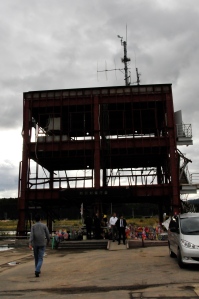 There is a red-colored steel skeleton of a building that had housed the Crisis Management Department. We heard the story of a young woman who worked there, saw the tsunami coming from the top floor, and began warning people by loudspeaker of its approach. She stayed at her post until the waters swept her away. She is credited with saving many lives.
There is a red-colored steel skeleton of a building that had housed the Crisis Management Department. We heard the story of a young woman who worked there, saw the tsunami coming from the top floor, and began warning people by loudspeaker of its approach. She stayed at her post until the waters swept her away. She is credited with saving many lives.
Immediately after the earthquake the mayor of the city called his staff and other personnel to the building in order to direct emergency operations. But the waters quickly drove them up to the roof, which must be over 50 feet above sea level. We saw a photo of the 30 or so people huddled on the roof and the rising waters just below the level of the roof. The next picture taken a few minutes later shows that the waves have engulfed the whole building. A few people cling to an antennae protruding out of the water. Reportedly only ten people (including the mayor) survived.
Minamisanriku had been a thriving town of 17,000. But 600 residents were known to have died in the tsunami and an additional 200 are still listed as missing. The night of the earthquake had freezing temperatures and snowfall, and many who were injured or stranded were left out in the open all night and into the next day. Many of these died due to exposure to the cold.
This site has become kind of a memorial to the disaster. An altar has been built at the base of the remains; bouquets of colorful flowers have been placed all around. We saw a small makeshift cross nearby. While we were there, a tour bus stopped and the passengers got out and paid their respects to the victims.
 It was a relief to leave the disaster area and go the short distance to the Shizugawa town center area, which is elevated and thus escaped the tsunami. Here OasisLife CARE has established the Leather Craft Project in a community center, where local women handcraft leather products, which OLC then purchases from them and markets. These women, who are not Christians or part of the Rifu church, have become leaders serving the recovering community here.
It was a relief to leave the disaster area and go the short distance to the Shizugawa town center area, which is elevated and thus escaped the tsunami. Here OasisLife CARE has established the Leather Craft Project in a community center, where local women handcraft leather products, which OLC then purchases from them and markets. These women, who are not Christians or part of the Rifu church, have become leaders serving the recovering community here.
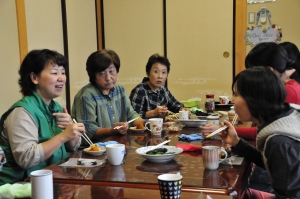 The women were happy to see us, and we all sat down together to share a light meal. Then we spent the rest of the morning working on the leather goods together. It was enjoyable work; all of the women have gotten to know each other over the months and seemed to share an easy, friendly relationship. We seemed a world away from the disaster area.
The women were happy to see us, and we all sat down together to share a light meal. Then we spent the rest of the morning working on the leather goods together. It was enjoyable work; all of the women have gotten to know each other over the months and seemed to share an easy, friendly relationship. We seemed a world away from the disaster area.
In the afternoon we stopped at the Christian Center, a building constructed by Samaritan’s Purse. Four young people live here, sleeping on the floor, and they help with the relief work and try to establish a Christian presence in the area. A pastor conducts a worship service here on Sunday, and it’s the only Christian church in the whole city.
Leaving Minamisanriku, I’m thinking about all we have seen today. It’s hard not to be awed by the power and fury of nature or, for me as a believer, the power and fury of God. But that raises difficult questions that I think about and that I’ve heard raised by others: Why would God cause, or let, such a terrible thing happen? Was the earthquake an act of God’s judgment on Japan? Who is this God who can toss houses and trucks and trees around like toys?
For me as a Christian, the answers are clear and truthful, although not easy or reassuring. The God of all power and majesty who spoke the universe into existence also created humans in his image to know him, to love him and be loved by him, and to rule with him. But through our rebellion we were estranged from him. Sin changed everything, poisoning our relationships with God and with each other, even contaminating our relationship to nature. In fact God said,
Cursed is the ground because of you; through painful toil you will eat of it all the days of your life. It will produce thorns and thistles for you and you will eat the plants of the field. – Genesis 3:17-28
So all of natural disaster and human suffering – earthquakes, tornados, famine, disease, injury, birth defects – have their genesis in sin. And as sons and daughters of Adam and Eve, we share in the culpability. In my view, the disaster here was not God’s judgment on Japan anymore than the earthquakes we’ve had in southern California were not God’s judgment on Whittier or Northridge. However, in a sense they are the result of God’s judgment on sin in general and remind us of the coming day of the Lord when he will judge all. Jesus warns us that in these last days not to be surprised because “there will be famines, great earthquakes, and pestilences in various places” (Luke 21:11).
As Christians we also know that God has provided a way of escape from sin and death and judgment through the life, substitutionary death, and resurrection of his son Jesus. And further we look forward to his return when he will restore us completely to himself and set all things right.
As I said, these are not very comfortable answers, but I take hope and comfort in clinging to what I know to be true and right and pure (Philippians 4:8).
 Tonight we had a wonderful dinner with two members of the Rifu church, Motoko and Tsukasa Hikichi. Tsukasa is trained as a professional chef, and when we arrived, he was attired in a chef’s toque and full garb. He had prepared a delicious meal of sushi for us all with platters of fresh meat and seafood. It was one of the best meals I’ve ever had.
Tonight we had a wonderful dinner with two members of the Rifu church, Motoko and Tsukasa Hikichi. Tsukasa is trained as a professional chef, and when we arrived, he was attired in a chef’s toque and full garb. He had prepared a delicious meal of sushi for us all with platters of fresh meat and seafood. It was one of the best meals I’ve ever had.
A word about food. Pastor Eiji told us that this northeast part of Japan takes pride in its food, with the abundance of seafood, rice and vegetable crops, and cattle. The people here have a culture of good food and fine dining. We’ve rarely eaten so well in our lives.
 The Hikichi’s have a wonderful story. Motoko came to the church 12 years ago at a desperate time in her life when she was contemplating suicide. Suicide is a severe problem in Japan with over 30,000 deaths last year, almost as many suicides as in the U.S., a much larger country. Motoko heard the gospel at the church and came to faith. Pastor Eiji met her during this time, and he said the change that came over her was remarkable. Her whole demeanor and outlook were transformed. As a result her husband Tsukasa began attending Oasis Chapel, later receiving Christ himself.
The Hikichi’s have a wonderful story. Motoko came to the church 12 years ago at a desperate time in her life when she was contemplating suicide. Suicide is a severe problem in Japan with over 30,000 deaths last year, almost as many suicides as in the U.S., a much larger country. Motoko heard the gospel at the church and came to faith. Pastor Eiji met her during this time, and he said the change that came over her was remarkable. Her whole demeanor and outlook were transformed. As a result her husband Tsukasa began attending Oasis Chapel, later receiving Christ himself.
At the end of our dinner with much good food and conversation across the table and across language and cultural barriers, Motoko said in English with a clear, strong voice, “I’m so happy we could be together. Let’s be friends!”
Friday, October 5, 2012
We’re staying for these few days at Morigo Camp, which is owned by the Rifu church. The camp is only a few minutes from the church but is situated in a forest up in the mountains, so you feel you’re far away from not only the church but any city life as well.
well.
This morning Ryota Miura who oversees the whole camp and property gave us a tour of the facility. Camp Morigo was built in 1961 with much assistance from Christian youth from California with Baptist Youth Fellowship. Since 3/11 many groups and organizations, including Samaritan’s Purse, have stayed at the camp, as OLC has opened it up for use by those who have come to help.
Pastor Steve and I were blown away by how beautiful and functional the whole camp is. It needs a little work, which the church is exploring, but they have a wonderful place here. One of the things we would like to do is help the Rifu church with an English language summer camp that would take place up here.
We spoke about such a camp later in the morning when we met with Pastor Makito. We established a three-year commitment to partner with Rifu Oasis Chapel. The first steps would be for our church to send a team made up of a couple of families to assist with the English language camp, which targets non-Christian youth from the tsunami-affected areas; in turn, the Rifu church would send some of their youth to our youth camp. We are looking forward to ways our two churches could be further involved, especially in their relief work.
In the afternoon we drove to the Higashi-Matsushima area where there is a large temporary housing project. There we met up with Mr. Ono, a 64-year-old resident of the area who had lost his house in the tsunami. Ono has become a leader and activist for the people of the project.
 He took us out to the harbor area where his vacant house still stands. When the tsunami struck, he was at work but his daughter-in-law and grandson were at home. They were able to escape, but many of his neighbors did not. There were once 650 houses in this area with 1500 residents; 350 were killed.
He took us out to the harbor area where his vacant house still stands. When the tsunami struck, he was at work but his daughter-in-law and grandson were at home. They were able to escape, but many of his neighbors did not. There were once 650 houses in this area with 1500 residents; 350 were killed.
Ono showed us some photographs of the area in the aftermath of the tsunami. One incredible aerial shot shows the shell of his house with a 200-ton ship from the harbor washed up on his front lawn.
Ono is unremittingly cheerful, always with a smile on his face. He said that he could keep a positive attitude despite the tragedy because he was thankful for his family’s safety. But then he said, “I’m not a priest or anything, but I lost a lot of friends and neighbors and shed a lot of tears. But all those tears made me gentle.”
I don’t think that Ono is a Christian, but his words reminded me of the apostle Paul’s: “We also rejoice in our suffering, because we know that suffering produces perseverance; perseverance, character; and character, hope” (Romans 5:3-4).
I don’t see how you can live in these circumstances, much less minister in them, much less minister with joy without that kind of attitude. As Christians we believe that God redeems our suffering by transforming our character to Christ likeness. Further, we believe that our suffering marks our position as children and heirs of God and identifies us with Christ’s own suffering (Romans 8:15-18).
So the Christian church really is the suffering church. We don’t experience that much in the affluent, therapeutic American church. But for the church in many places in the world, including here in Japan, “the sufferings of Christ flow over into our lives, so also through Christ our comfort overflows” into ministry and service to the world (2 Corinthians 1:5).
As we were leaving, Mr. Ono told us that he doesn’t want anything from us personally, but only to go back and tell people what happened here.
Saturday, October 6, 2012
This morning we went with about 20 church members to the fishing village of Yoriiso, a couple of hours north of Rifu. Yoriiso is located in the general area of Ishinomaki, which sustained the most deaths of the 20,000 total fatalities from the tsunami.
 We were on our way to Yoriiso to take food and supplies to the residents. This has been a regular part of OasisLife CARE’s ministry. Yoriiso had been a thriving fishing village of 300 people nestled above an inlet of the ocean. Huge waves over 70 feet high wiped out the village, sparing only the houses above that level. Looking at the remains of the village today, you can imagine what a quaint, lovely place this had been. There must be many such villages dotting the Japanese coast.
We were on our way to Yoriiso to take food and supplies to the residents. This has been a regular part of OasisLife CARE’s ministry. Yoriiso had been a thriving fishing village of 300 people nestled above an inlet of the ocean. Huge waves over 70 feet high wiped out the village, sparing only the houses above that level. Looking at the remains of the village today, you can imagine what a quaint, lovely place this had been. There must be many such villages dotting the Japanese coast.
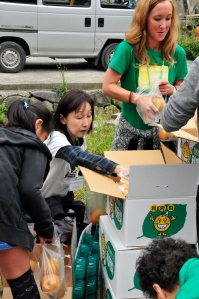 When we finally arrived, we formed teams and assembled bags filled with Japanese staples (soy sauce, miso, cooking oil, etc.) for distribution to the residents, who began to gather as we worked. We set out tables and chairs, and when we had finished our packages, we served refreshments to the women who had come.
When we finally arrived, we formed teams and assembled bags filled with Japanese staples (soy sauce, miso, cooking oil, etc.) for distribution to the residents, who began to gather as we worked. We set out tables and chairs, and when we had finished our packages, we served refreshments to the women who had come.
I say “women” because I noticed that there were no men in the group. I figured that the men must have been off somewhere working. When I looked up at the houses on the hillsides, I saw the men working up there. One of the women from our group, a young woman from southern California named Alea Eurich, took refreshments and hurried up the steps to serve the workers up there. Pastor Steve was impressed by her example of a servanthood that doesn’t wait but goes out to meet needs.
Alea felt God calling her to Japan and is working as an English teacher; she attends Rifu Oasis Chapel. Another person who went with us was Florence Chiu, a young woman from Hong Kong who grew up in Australia. Alea and Florence, along with Emi Kato and some of the young men we met at the Christian Center in Minamisanriku, are examples of the many young people who have come to Japan to serve in the aftermath of the disaster.
 After we had finished serving the people and distributing the bags, we walked around the area. We climbed the steep stairways and paths to the homes on the hillside and stopped to talk with the residents.
After we had finished serving the people and distributing the bags, we walked around the area. We climbed the steep stairways and paths to the homes on the hillside and stopped to talk with the residents.
When we came back down, we walked along the waterfront. The tsunami had battered the dock area, but the fishing activity was slowly trying to make a comeback, with two boats now able to go out for scallops and hoya (sea squirts or sea pineapples). The Rifu church is ministering to the fishermen as well, and one of them came over to greet us. He was a big, burly man, and he particularly hit it off with Pastor Steve. They joked around and laughed even though I’m sure they didn’t understand a word of what each other was saying. I thought to myself that this must be just the kind of guy that Jesus called to leave his boat and nets and follow him.
We made the long trip back to Rifu. It had been a full, tiring day, but one which these church people have experienced many of since 3/11. We returned to Morigo Camp in the evening with Florence, who is staying there for a few days.
Pastor Steve and I talked with Florence late into the night. She has been serving in Japan since shortly after the earthquake, leading teams from Hong Kong to join with Grace Mission Tohoku and Samaritan’s Purse in restoring houses in the Ishinomaki area. Many of the houses there were two-story structures that were badly damaged by the floods on the first floor, but salvageable on the second. Relief teams cleaned up and cleared out the damaged areas so that carpenters and other craftsmen could come in and rebuild the house.
It was very time- and labor-intensive work, but Florence said that they had been able to form good relationships with many of the homeowners, some of which were still living on the second floor during construction. They had been able to talk and pray with these residents. A few of them have become Christians through their friendships with the workers.
Florence also shared with us about the phenomenon of the hikikomori, which along with suicide is a major social problem in Japan. The hikikomori are adolescents and young adults who withdraw from society. They become recluses in their own homes, sleeping during the day and watching TV or playing on the computer at night. I was aware of the problem because my wife has a relative in Japan who is one. Japan’s Ministry of Health estimates that there are 3.6 million hikikomori in Japan. Florence said that one young man at Oasis Chapel was a hikikomori whom God had redeemed from that life.
Sunday, October 7, 2012
Today is Sunday and I’m pretty tired from the past week.
We attended Rifu Oasis Chapel’s worship service. They have a beautiful, light-filled space and two services, with about 70 worshippers each week, a relatively large church in Japan.
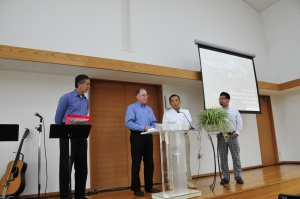 Pastor Steve gave a short greeting. Pastor Eiji preached the message, and we presented a plaque with a blessing from our church to theirs.
Pastor Steve gave a short greeting. Pastor Eiji preached the message, and we presented a plaque with a blessing from our church to theirs.
The style of their worship service had very much the feel of a Japanese-American service (as much as that might vary). It was comfortable and easy worshiping here, despite the obvious language difficulty. (Takeshi Takazawa, a friend of our church from back in the U.S. who works with Asian Access, graciously translated the service for Pastor Steve and me.)
 Worship was joyful, heartfelt, and God-centered, and I appreciated it very much. This past week the church had experienced the death of the father of one of its members, a prominent man in the community. The church was still feeling the effects of that. I thought to myself just how important it is for a church that is daily ministering outwardly to a needy, hurting world and struggling inwardly with its own needs and hurts, how important it is to gather as God’s people to worship him, to be refocused and renewed.
Worship was joyful, heartfelt, and God-centered, and I appreciated it very much. This past week the church had experienced the death of the father of one of its members, a prominent man in the community. The church was still feeling the effects of that. I thought to myself just how important it is for a church that is daily ministering outwardly to a needy, hurting world and struggling inwardly with its own needs and hurts, how important it is to gather as God’s people to worship him, to be refocused and renewed.
At the end of worship, the young man who played the keyboard with the worship team came forward to give the announcements. But he was so overcome with emotion that he could barely get out the words. Florence told me later that he was the one who had been a hikikomori and that Pastor Eiji’s sermon and just the act of worship had touched his heart with how far God had brought him.
 In the afternoon the people of Oasis Chapel threw a BBQ for us at Morigo Camp. They hauled out big charcoal grills and cooked all sorts of meat, seafood, and vegetables. It was a wonderful time of feasting and sharing together, with the children running all over the place (what a great place for kids!). Ryota brought out his dog and goat(!), which pranced around and also got to feast on the vegetation growing there.
In the afternoon the people of Oasis Chapel threw a BBQ for us at Morigo Camp. They hauled out big charcoal grills and cooked all sorts of meat, seafood, and vegetables. It was a wonderful time of feasting and sharing together, with the children running all over the place (what a great place for kids!). Ryota brought out his dog and goat(!), which pranced around and also got to feast on the vegetation growing there.
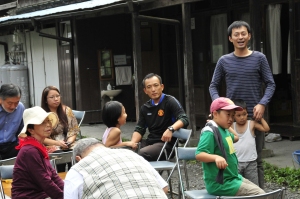 We all played a game where team members were instructed to guess or find out different facts about Pastor Steve, Pastor Eiji, GVBC, and myself. A brief rainstorm drove us under cover but didn’t spoil our fun.
We all played a game where team members were instructed to guess or find out different facts about Pastor Steve, Pastor Eiji, GVBC, and myself. A brief rainstorm drove us under cover but didn’t spoil our fun.
Tonight we bought some food (as stuffed as we still were from the BBQ) and went over to Pastor Makito’s house for a last dinner with his staff and family. It was a relaxed, intimate evening – a perfect end to our stay in Rifu.
Our time at Rifu Oasis Chapel has been marked with an unmistakable sense of family. We’ve been privileged to get to know our brothers and sisters here, to work along side of them, to grow to love them, and for a few short days to be a part of their family.
Monday, October 6, 2012
As we drove away from Camp Morigo this morning, Pastor Eiji said that Pastor Makito and his wife expressed to him how thankful they were for our time with them. They said that in the months since 3/11, many organizations and relief groups have approached the church wanting to help, but they usually have one of two approaches: either they have their own agenda they want to impose on OasisLife CARE or they want to see how their resources match with what OLC is doing before they decide if they want to be involved.
Pastor Makito said that he was grateful that we took time to talk with them, to listen, and to see how we could come along side and help.
We caught the Shinkansen back to Tokyo and then took a bus to the city of Itako an hour away. Itako is Pastor Eiji’s hometown, and we went to Itako Baptist Church, where he grew up and where his parents still attend. When we entered the church, the group of 20 or so ladies applauded us (probably Pastor Eiji mostly), and he introduced them as “all my mothers.”
We met Eiji’s real mother and father, as well as his brother Shohei, and Reverend Shigemi Ono, the pastor of the church. He and his father, whom he succeeded, have pastored this church for over 50 years.
 Pastor Eiji’s family had moved to Itako when he was nine-years-old. Both Shohei and Pastor Ono described the young Eiji as “very active” which I think is polite code for something else. Coming to Itako, the Osato family was not religious, but an acquaintance of Mrs. Osato, whom she didn’t particularly like, began to invite her to the Itako church. The woman persisted with the invitations, so Mrs. Osato finally relented just to get her off her back. At the church service she was deeply moved by God and later received Christ. The rest is history.
Pastor Eiji’s family had moved to Itako when he was nine-years-old. Both Shohei and Pastor Ono described the young Eiji as “very active” which I think is polite code for something else. Coming to Itako, the Osato family was not religious, but an acquaintance of Mrs. Osato, whom she didn’t particularly like, began to invite her to the Itako church. The woman persisted with the invitations, so Mrs. Osato finally relented just to get her off her back. At the church service she was deeply moved by God and later received Christ. The rest is history.
Pastor Ono will be leaving Itako in April to lead a church in Yokohama. Pastor Steve and Pastor Eiji addressed the church members and spoke about change. It seemed their words were timely, well-received, and edifying.
This evening we had dinner with Pastor Eiji’s family and Reverend and Mrs. Ono at a small restaurant nearby. We shared food and warm conversation for several hours.
Tuesday, October 9, 2012
Today is our last day in Japan.
Pastor Steve and I stayed last night at a hotel in Itako. Japanese hotels charge by the person and not the room, so he and I each got a separate room. Actually it was several rooms: a sleeping area with two beds, a living room area with sofas, a large tatami room, a big bathroom, and huge walk-in closets. I think it was designed to sleep eight people because eight slippers were laid out.
The hotel was built to accommodate sports teams, with a soccer stadium nearby. We were told that 600 people had stayed the weekend, and when we checked in yesterday we saw many of them. But when we woke this morning, we were the only ones there.
 When we went down for breakfast to the large dining room, they had laid out a fabulous banquet for just the two of us. Pastor Steve and I counted over 12 different dishes of American or traditional Japanese fare. The hostess waited on us attentively. I felt like one of the elect, or at least a minor celebrity.
When we went down for breakfast to the large dining room, they had laid out a fabulous banquet for just the two of us. Pastor Steve and I counted over 12 different dishes of American or traditional Japanese fare. The hostess waited on us attentively. I felt like one of the elect, or at least a minor celebrity.
After breakfast Pastor Eiji, who had stayed the night at his parent’ house, picked us up and took us to the Cooking House. This is a large two-story house that a couple from the Itako church has built next to their own house. They opened a restaurant in it to serve the community, and women from the church come here each day to cook. The couple has a mentally disabled son, and this young man helps to serve the customers. There are other disabled young people in the Itako church, and the Cooking House is a place for them to work and earn some money.
 We had tea and coffee with the staff, and Pastor Steve prayed for them as they began their day. Then we formed a circle, held hands, and said the Lord’s Prayer together.
We had tea and coffee with the staff, and Pastor Steve prayed for them as they began their day. Then we formed a circle, held hands, and said the Lord’s Prayer together.
We returned to the Cooking House for lunch. The women from the church had prepared a delicious meal for us, and we enjoyed the last of our many, many wonderful meals in Japan.
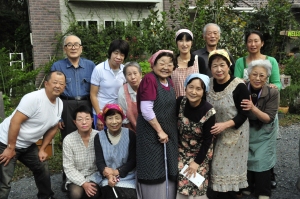 Before we knew it, it was time to go. We said our hurried goodbyes. Pastor Eiji lingered, sharing his last heartfelt goodbyes with all of his loved ones here. His mother hugged me and told me in Japanese to take care of her boy. We drove off to the airport, bidding farewell to all these dear saints and to Japan.
Before we knew it, it was time to go. We said our hurried goodbyes. Pastor Eiji lingered, sharing his last heartfelt goodbyes with all of his loved ones here. His mother hugged me and told me in Japanese to take care of her boy. We drove off to the airport, bidding farewell to all these dear saints and to Japan.
Photos by Pastor Stephen Langley
